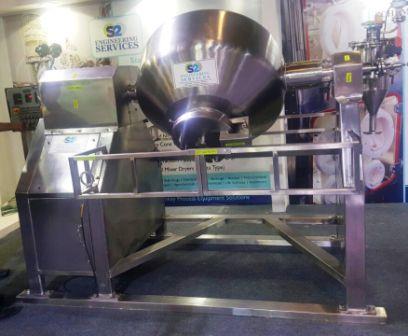
Vacuum dryers are used in many applications in most industrial sectors, including chemical, pharmaceutical, food, plastics and metal powders.
The vacuum dryer is the centre piece of a vacuum drying system that also incorporates media heating and circulating, vacuum, and solvent-recovery components. The dryer consists of an enclosed, thermal jacketed vessel that serves as the drying chamber. The vessel is usually constructed from stainless steel or special alloys to match your requirements, and the vessel capacity is typically from 100 Litres to 16,000 Litres (1 to 500 cubic feet).
Several heat sources can be employed to supply hot media to the thermal jacket, depending on the temperature and resulting BTU requirements. Typically piped plant steam is used in the jacket or, to avoid condensate problems, use heating elements and a heat exchanger to heat a fluid (usually water or oil) for the jacket. The hot media flows through the dryer's thermal jacket to transfer heat to the drying chamber.
Correctly specifying the thermal jacket and media heating and circulating components and ensuring that the media flow rates and pressure are compatible with the jacket are important factors in successful vacuum drying. Be aware that using steam or pressurised hot water or oil in the jacket often requires a high pressure jacket design (to handle a positive pressure higher than 1 atmosphere). The high-pressure jacket allows better media flow rates and heat transfer through the jacket to the dryer wall, but the jacket design will need to meet the rigorous requirements of the ASME Code for unfired pressure vessels.
A vacuum line runs from the dryer to the vacuum source, usually a vacuum pump, which reduces the atmospheric pressure in the dryer. The vacuum pump is primarily responsible for the vacuum level in the dryer, as long as the vessel is properly welded and the vacuum line is effectively sealed to the vessel. The most common type is a liquid ring vacuum pump.
The sealing liquid in this pump can be water, oil, or a compatible solvent. The pump typically produces a vacuum in the range of 100 torr. For an application requiring a very high vacuum (atmosphere as low 0.1 torr), you can use a rotary blower and air injectors to boost the liquid ring pump's capability.
The vacuum line pulls off the vapours that exit the dryer as the wet material dries. The vapours are captured by a condensing system located between the vacuum pump and the dryer. The system typically includes a precondenser and a condensate receiver tank. The precondenser is chilled to condense the vapour, and the condensed water or solvent is captured in the condensate receiver tank. A condensate pump removes the condensate from the tank.
In some cases - such as when the solvent is toxic or hazardous and would pose an environmental hazard if discarded without special treatment - the solvent can also be used for the sealant in the liquid ring vacuum pump. This requires equipping the vacuum with a condensing system that has a closed-loop sealant arrangement.
S2 has a wealth of experience in designing bespoke drying equipment for specific customer applications. For further information please contact the S2 Engineering Technical Support Team.


